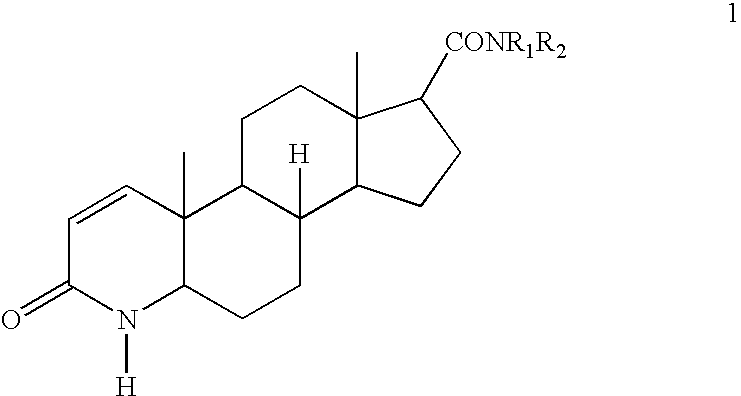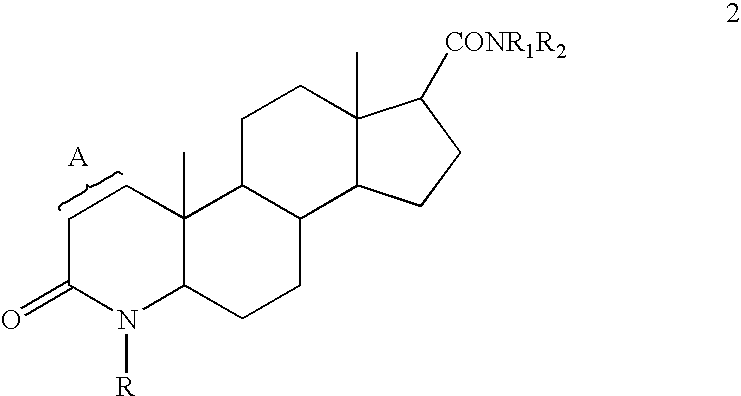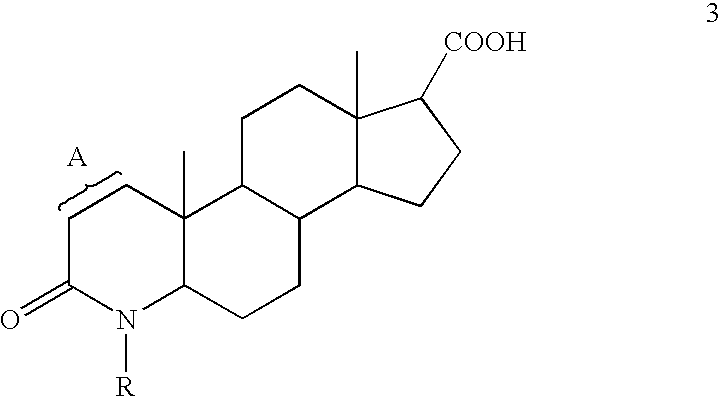Process for the preparation of 17-N-substituted-carbamoyl-4-aza-androst-1-en-3-ones
a technology of carbamoyl and aza and aza, which is applied in the field of process for producing 17nsubstituted carbamoyl4azaandrost1en3ones, which can solve the problems of difficult purification of products, high cost of organomagnesium halide, and high cost of dithiopyridin
- Summary
- Abstract
- Description
- Claims
- Application Information
AI Technical Summary
Problems solved by technology
Method used
Image
Examples
example 1
N-tert-Butyl-3-oxo4-aza-5α-androstane-17β-carboxamide
[0069] To a stirring mixture of 3-oxo-4-aza-5α-androstane-17β-carboxylic acid (20 g, 62.6 mmol) in dry N-methyl-2-pyrrolidinone (100 mL) was added 1,1′-carbonyldiimidazole (11.2 g, 68.9 mmol) and the reaction mixture was stirred at controlled room temperature (20-30° C.). After 5 hours, HPLC analysis showed no remaining starting material and the reaction mixture was placed into a high pressure vessel along with 2-hydroxypyridine (3.0 g, 31.3 mmol) and tert-butylamine (9.2 g, 125.2 mmol). With an oil bath temperature of 100° C. and an internal pressure of 10-20 psi, the reaction mixture was stirred. After 6 hours, TLC analysis showed no remaining starting material, and the reaction mixture was cooled to room temperature (20-25° C.), charged with deionized water (100 mL) and stirred at 5-10° C. for 4 hours. The resulting slurry was filtered and washed with deionized water. To this solid was added deionized water (200 mL) and the re...
example 2
N-tert-Butyl-2-phenylsulfenyl-3-oxo4-aza-5α-androstane-17β-carboxamide
[0070] N-tert-Butyl-3-oxo-4-aza-5α-androstane-17β-carboxamide (10 g, 26.7 mmol) obtained from example I was added to dry tetrahydrofuran (100 mL) and the resulting slurry was cooled to −20° C. Lithium bis(trimethylsilyl)amide in tetrahydrofuran (24 wt % in THF) (22.3 g, 32.0 mmol) was added dropwise to the mixture, and the resulting slurry was stirred at −20° C. for 30 minutes. To the slurry was added di-tert-butyl-dicarbonate (6.4 g, 29.3 mmol) in portions at −20° C. After 1 hour, TLC and HPLC analyses indicated the absence of starting material, and the reaction mixture was charged with phenyl disulfide (6.4 g, 29.4 mmol). Lithium bis(trimethylsilyl)amide in tetrahydrofuran (24 wt % in THF) (27.9 g, 40.0 mmol) was added dropwise, and the resulting reaction mixture was stirred at −20° C. for 2 hours. TLC and HPLC analyses showed no remaining starting material, and the reaction mixture was charged with deionized w...
example 3
N-tert-Butyl-3-oxo-4-aza-5α-androst-1-en-17β-carboxamide (Finasteride)
[0071] Sodium metaperiodate (8.0 g, 37.4 mmol) was added to a solution of N-tert-butyl-2-phenylsulfenyl-3-oxo-4-aza-5α-androstane-17β-carboxamide (9.0 g, 18.6 mmol) obtained from example 2 in methanol (90 mL) and the resulting slurry was stirred at room temperature. Following the dropwise addition of deionized water (18 mL), the reaction mixture was stirred at room temperature. After stirring a further 6 hours, the reaction mixture was filtered, and the precipitate was washed several times with ethyl acetate. Deionized water was then added to the reaction mixture and the layers were separated. The organic layer was evaporated and the residue was dissolved in toluene and the resulting solution was heated to reflux. After 1 hour, the reaction mixture was cooled to room temperature. After the addition of the equivalent volume of heptanes, the reaction slurry was cooled to 0-5° C., maintained for 4-5 hours, filtered,...
PUM
| Property | Measurement | Unit |
|---|---|---|
| temperature | aaaaa | aaaaa |
| temperature | aaaaa | aaaaa |
| temperature | aaaaa | aaaaa |
Abstract
Description
Claims
Application Information
 Login to View More
Login to View More - R&D
- Intellectual Property
- Life Sciences
- Materials
- Tech Scout
- Unparalleled Data Quality
- Higher Quality Content
- 60% Fewer Hallucinations
Browse by: Latest US Patents, China's latest patents, Technical Efficacy Thesaurus, Application Domain, Technology Topic, Popular Technical Reports.
© 2025 PatSnap. All rights reserved.Legal|Privacy policy|Modern Slavery Act Transparency Statement|Sitemap|About US| Contact US: help@patsnap.com



